
|
Appearing in the evening sky in the Southern Hemisphere. Now it is bright, but fading rapidly as 7.7 mag on Aug. 17 and 9.0 mag on Aug. 20 (Chris Wyatt). It will keep observable while fading rapidly after this in the Southern Hemisphere. It is not observable in the Northern Hemisphere.
Date(TT) R.A. (2000) Decl. Delta r Elong. m1 Best Time(A, h)
Aug. 28 12 19.13 -9 15.1 1.115 0.633 34 9.4 19:02 ( 90, 17)
Sept. 4 13 9.96 -15 32.8 1.123 0.761 41 10.7 19:06 ( 87, 24)
|
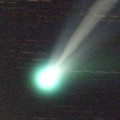
|
Appearing in the morning sky in the Southern Hemisphere. It approached to the sun down to 0.4 A.U. in July, and was expected to reach up to 2-3 mag. But actually, it brightened only up to 5 mag at best. It will keep observable while fading after this in the Southern Hemisphere. In the Northern Hemisphere, it will never be observable again.
Date(TT) R.A. (2000) Decl. Delta r Elong. m1 Best Time(A, h)
Aug. 28 9 48.70 -24 25.2 2.015 1.328 35 9.5 5:01 (293, 9)
Sept. 4 10 0.39 -29 6.1 2.098 1.450 38 10.0 4:51 (297, 13)
|
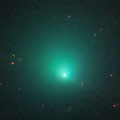
|
Brightened rapidly. Now it is so bright as 8.4 mag (Aug. 18, Alexandre Amorim). It keeps observable bright as 9-10 mag for a long time until autumn. A thin straight dust trail is visible.
Date(TT) R.A. (2000) Decl. Delta r Elong. m1 Best Time(A, h)
Aug. 28 1 36.81 -14 37.8 0.651 1.531 133 9.6 3:13 (180, 70)
Sept. 4 1 39.39 -16 6.5 0.656 1.558 137 9.8 2:48 (180, 71)
|
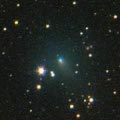
|
Brightening rapidly. Now it is 11.4 mag (Aug. 21, Jakub Cerny). This apparition is best condition. It will approach to the earth down to 0.12 A.U. in October, and brighten up to 5 mag. It will be visible with naked eyes. In the Northern Hemisphere, it keeps observable all through this apparition until 2011 June when it fades down to 17 mag. In the Southern Hemisphere, it becomes unobservable temporarily from late September to mid October. But then it keeps observable in good condition.
Date(TT) R.A. (2000) Decl. Delta r Elong. m1 Best Time(A, h)
Aug. 28 22 46.44 35 52.5 0.428 1.343 133 10.4 0:23 (180, 19)
Sept. 4 22 53.96 39 25.3 0.369 1.290 133 9.8 0:03 (180, 16)
|
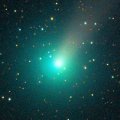
|
It brightened up to 7.9 mag in April and May (May 5, Juan Jose Gonzalez). Now it is fading. But it is still bright as 10.8 mag (Aug. 20, Juan Jose Gonzalez). It keeps observable for a long time until when it fades out in the Northern Hemisphere. It will be visible visually until autumn. It is not observable in the Southern Hemisphere.
Date(TT) R.A. (2000) Decl. Delta r Elong. m1 Best Time(A, h)
Aug. 28 8 13.84 52 15.7 2.688 2.182 50 11.5 5:01 (218,-18)
Sept. 4 8 14.93 51 43.1 2.678 2.250 54 11.7 4:51 (217,-15)
|
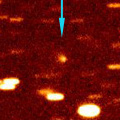
|
It brightened up to 15.5 mag in January (Jan. 31, C. Rinner, F. Kugel). It is not observable now. The condition of this apparition is bad. It has not been observable at all around the maximum brightness. It will appear in the morning sky in October.
Date(TT) R.A. (2000) Decl. Delta r Elong. m1 Best Time(A, h)
Aug. 28 9 1.85 8 38.0 2.404 1.502 20 12.4 5:01 (260, 0)
Sept. 4 9 21.02 6 33.6 2.421 1.536 22 12.6 4:51 (261, 1)
|
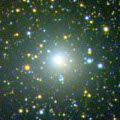
|
It reached up to 7.7 mag in last summer (2009 Aug. 13, Chris Wyatt). It is fading now. It has already faded down to 12.6 mag (Aug. 7, Marco Goiato). In the Southern Hemisphere, it keeps observable for a long time after this. In the Northern Hemisphere, it is only observable in the extremely low sky. It will be getting lower gradually, then it will never be observable again.
Date(TT) R.A. (2000) Decl. Delta r Elong. m1 Best Time(A, h)
Aug. 28 17 24.33 -47 41.3 4.575 4.968 107 13.0 19:02 ( 3, 77)
Sept. 4 17 19.79 -47 33.1 4.735 5.015 100 13.1 19:06 ( 28, 75)
|
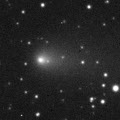
|
Now it is 11.7 mag (Aug. 6, Juan Jose Gonzalez). It will keep 12-13 mag until autumn. It is observable in excellent condition in the Southern Hemisphere. It locates somewhat low in the Northern Hemisphere.
Date(TT) R.A. (2000) Decl. Delta r Elong. m1 Best Time(A, h)
Aug. 28 20 37.02 -33 27.8 1.774 2.671 145 13.2 22:10 (180, 88)
Sept. 4 20 34.52 -33 19.4 1.842 2.687 139 13.3 21:40 (180, 88)
|

|
Now it is unobservable. It will appear in the morning sky again in October.
Date(TT) R.A. (2000) Decl. Delta r Elong. m1 Best Time(A, h)
Aug. 28 10 20.18 7 9.0 7.235 6.227 3 14.3 5:01 (272,-15)
Sept. 4 10 25.02 6 37.1 7.229 6.228 6 14.3 4:51 (271,-12)
|

|
Already bright as 12.8 mag and visible visually (Aug. 20, Juan Jose Gonzalez). It is expected to keep so bright as 6-8 mag for a long time from 2011 to 2012, and to be observable in good condition in the Northern Hemisphere. In 2010, it is observable in good condition in the Southern Hemisphere while brightening slowly. It locates low in the Northern Hemisphere, but it keeps observable until the end of 2010.
Date(TT) R.A. (2000) Decl. Delta r Elong. m1 Best Time(A, h)
Aug. 28 23 14.51 -37 42.1 4.731 5.629 150 14.4 0:52 ( 0, 87)
Sept. 4 23 6.27 -38 0.9 4.678 5.568 149 14.3 0:16 ( 0, 87)
|
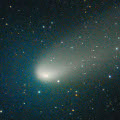
|
It reached up to 9.2 mag in March (Mar. 20, Marco Goiato). Now it is fading. It has already faded down to 12.2 mag (Aug. 6, Juan Jose Gonzalez). It keeps observable in a good condition for a long time. It keeps observable until autumn when it fades down to 16 mag.
Date(TT) R.A. (2000) Decl. Delta r Elong. m1 Best Time(A, h)
Aug. 28 15 43.30 -16 56.8 2.242 2.344 83 14.6 19:02 (121, 61)
Sept. 4 15 54.36 -17 41.7 2.363 2.385 78 14.8 19:06 (114, 57)
|
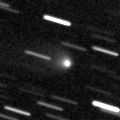
|
Now it is 15.3 mag (July 18, Hiroshi Abe). It will be observable at 13-14 mag for a long time from 2011 to 2012. In 2010, it is observable at 15-16 mag in good condition from spring to autumn.
Date(TT) R.A. (2000) Decl. Delta r Elong. m1 Best Time(A, h)
Aug. 28 20 49.19 -1 6.9 5.848 6.774 154 15.1 22:22 (180, 56)
Sept. 4 20 43.03 -1 40.3 5.868 6.742 147 15.1 21:48 (180, 57)
|
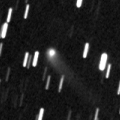
|
Now it is very bright as 14.2 mag (July 8, Toni Scarmato). It keeps observable at 14-15 mag for a long time in 2010. It locates in good condition in the Northern Hemisphere. It locates low, and will be unobservable in October in the Southern Hemisphere.
Date(TT) R.A. (2000) Decl. Delta r Elong. m1 Best Time(A, h)
Aug. 28 17 26.80 39 46.4 4.313 4.519 95 15.2 19:02 (180, 15)
Sept. 4 17 29.01 39 5.1 4.354 4.516 92 15.2 19:06 (174, 16)
|
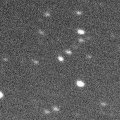
|
Now it is 15.0 mag (June 2, Hidetaka Sato). It keeps bright as 14-15 mag for a long time after this until 2013. It is observable in good condition in the Southern Hemisphere. However, it is not observable in the Northern Hemisphere.
Date(TT) R.A. (2000) Decl. Delta r Elong. m1 Best Time(A, h)
Aug. 28 14 22.95 -47 40.8 6.652 6.514 77 15.3 19:02 ( 55, 54)
Sept. 4 14 24.87 -47 49.2 6.719 6.487 72 15.3 19:06 ( 55, 49)
|
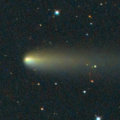
|
It brightened up to 9.5 mag in January (Jan. 13, Juan Jose Gonzalez). Now it is fading. But it is still bright as 14.5 mag (Aug. 9, Toshiyuki Takahashi). It will be also visible visually still now. It will be fainter than 18 mag at the end of 2010. In the Northern Hemisphere, it keeps observable for a long time, although it will be getting lower gradually. It is not observable in the Southern Hemisphere.
Date(TT) R.A. (2000) Decl. Delta r Elong. m1 Best Time(A, h)
Aug. 28 15 19.76 45 17.0 4.342 4.134 71 15.5 19:02 (158, 5)
Sept. 4 15 27.33 43 54.2 4.428 4.191 69 15.7 19:06 (153, 4)
|
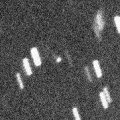
|
Now it is 14.8 mag, much brighter than this ephemeris (Aug. 21, Hidetaka Sato). It was predicted to be 14 mag in winter. But maybe it will be brighter and visible visually. It keeps observable in good condition from autumn to next spring.
Date(TT) R.A. (2000) Decl. Delta r Elong. m1 Best Time(A, h)
Aug. 28 7 37.63 29 31.8 4.012 3.356 43 16.1 5:01 (231, 2)
Sept. 4 7 41.22 28 17.8 3.892 3.324 49 16.0 4:51 (230, 5)
|

|
It keeps 16 mag until the end of 2010. It keeps observable in good condition in the Southern Hemisphere. But it is not observable at all in the Northern Hemisphere. It must have been bright, but no observations have been reported since May.
Date(TT) R.A. (2000) Decl. Delta r Elong. m1 Best Time(A, h)
Aug. 28 8 23.57 -42 43.9 3.144 2.772 59 16.4 5:01 (302, 33)
Sept. 4 8 26.19 -45 10.6 3.093 2.761 61 16.4 4:51 (304, 37)
|
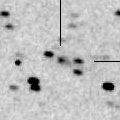
|
Recovered as bright as expected. Now it is 16.5 mag (Aug. 11, Hidetaka Sato). It is observable at 15.5 mag in good condition from autumn to winter. It locates somewhat low in the Southern Hemisphere.
Date(TT) R.A. (2000) Decl. Delta r Elong. m1 Best Time(A, h)
Aug. 28 5 25.19 14 43.6 2.207 2.144 73 16.7 5:01 (215, 33)
Sept. 4 5 37.25 15 35.1 2.127 2.137 76 16.6 4:51 (213, 33)
|
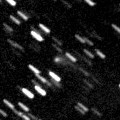
|
Now it is 16.5 mag (July 11, C. Rinner, F. Kugel). In the Northern Hemisphere, it keeps observable while fading gradually, and it will be fainter than 18 mag in November. In the Southern Hemisphere, it will never be observable again in this apparition.
Date(TT) R.A. (2000) Decl. Delta r Elong. m1 Best Time(A, h)
Aug. 28 6 39.46 62 53.2 2.804 2.571 66 16.9 5:01 (201,-15)
Sept. 4 7 1.75 63 59.1 2.797 2.620 69 17.0 4:51 (200,-16)
|
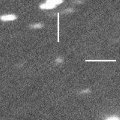
|
Now it is 17.4 mag (July 11, C. Rinner, F. Kugel). It keeps 17 mag for a long time from 2009 to 2012. It is observable in good condition in the Northern Hemisphere. It locates somewhat low in the Southern Hemisphere.
Date(TT) R.A. (2000) Decl. Delta r Elong. m1 Best Time(A, h)
Aug. 28 2 18.89 21 18.6 7.725 8.200 114 17.1 3:55 (180, 34)
Sept. 4 2 15.13 21 14.3 7.608 8.191 122 17.0 3:24 (180, 34)
|
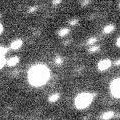
|
It was observed at 17 mag in summer and autumn in 2009. It will be observable again at 17 mag in summer and autumn also in 2010. It locates in good condition in the Northern Hemisphere, but somewhat low in the Southern Hemisphere.
Date(TT) R.A. (2000) Decl. Delta r Elong. m1 Best Time(A, h)
Aug. 28 3 16.70 23 7.2 2.227 2.622 101 17.1 4:53 (180, 32)
Sept. 4 3 20.89 23 8.7 2.159 2.641 107 17.1 4:30 (180, 32)
|

|
Now it is 16.9 mag (July 18, Yasukazu Ikari). Now it is brightest. It will be fainter than 18 mag in November. It locates in excellent condition in the Southern Hemisphere, but it locates low in the Northern Hemisphere.
Date(TT) R.A. (2000) Decl. Delta r Elong. m1 Best Time(A, h)
Aug. 28 20 36.27 -33 59.9 2.350 3.232 145 17.1 22:10 (180, 89)
Sept. 4 20 33.34 -34 0.4 2.409 3.235 138 17.2 21:39 (180, 89)
|
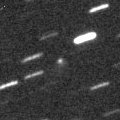
|
Now it is 16.7 mag (June 13, Hidetaka Sato). The condition keeps good, but it will be fainter than 18 mag in November.
Date(TT) R.A. (2000) Decl. Delta r Elong. m1 Best Time(A, h)
Aug. 28 18 51.05 0 44.1 2.792 3.479 125 17.1 20:24 (180, 54)
Sept. 4 18 41.06 0 59.3 2.916 3.494 117 17.3 19:47 (180, 54)
|
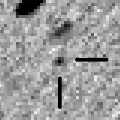
|
Now it is 19.3 mag (July 21, W. Hasubick). It will be observable at 17 mag in good condition from autum to winter in the Northern Hemisphere. But actually, it is much fainter than expected. It is not observable in the Southern Hemisphere.
Date(TT) R.A. (2000) Decl. Delta r Elong. m1 Best Time(A, h)
Aug. 28 2 44.47 38 46.4 1.991 2.422 102 17.3 4:21 (180, 16)
Sept. 4 2 48.14 40 54.9 1.924 2.424 107 17.3 3:57 (180, 14)
|
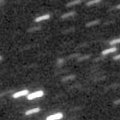
|
Now it is 17.2 mag (July 21, Ken-ichi Kadota). It keeps 17-18 mag for a long time until 2011 summer. It will be getting lower after this and will be unobservable in late autumn. But it will be observable again in 2011. The condition in 2011 will be good in the Northern Hemisphere, but it locates low in the Southern Hemisphere.
Date(TT) R.A. (2000) Decl. Delta r Elong. m1 Best Time(A, h)
Aug. 28 18 24.94 12 26.9 3.497 4.046 116 17.3 19:58 (180, 43)
Sept. 4 18 16.63 12 6.8 3.587 4.033 109 17.4 19:22 (180, 43)
|
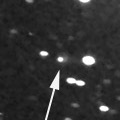
|
It reached up to 16.2 mag in early summer (June 7, P. C. Sherrod). Now it is fading. It keeps observabe in good condition until October when it becomes fainter than 18 mag in the Southern Hemisphere. But it locates somewhat low in the Northern Hemisphere.
Date(TT) R.A. (2000) Decl. Delta r Elong. m1 Best Time(A, h)
Aug. 28 16 2.47 -15 30.0 2.287 2.455 87 17.5 19:02 (130, 63)
Sept. 4 16 12.31 -16 39.7 2.367 2.457 83 17.6 19:06 (121, 60)
|
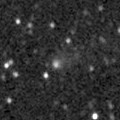
|
It reached up to 14.1 mag and became visible visually in May (May 6, Chris Wyatt). But now it is fading. It has already faded down to 17.5 mag (Aug. 3, Ken-ichi Kadota). It will be fainter than 18 mag soon. It locates in good condition in the Southern Hemisphere, but somewhat low in the Northern Hemisphere.
Date(TT) R.A. (2000) Decl. Delta r Elong. m1 Best Time(A, h)
Aug. 28 17 19.97 -21 54.3 1.670 2.180 106 17.5 19:02 (173, 77)
Sept. 4 17 30.54 -21 48.6 1.783 2.222 101 17.7 19:06 (153, 75)
|

|
It reached up to 11 mag in 2009 spring. Now it is fading. It has already faded down to 17.0 mag (Aug. 3, Ken-ichi Kadota). It will be fainter than 18 mag soon. It locates in good condition in the Southern Hemisphere, but somewhat low in the Northern Hemisphere.
Date(TT) R.A. (2000) Decl. Delta r Elong. m1 Best Time(A, h)
Aug. 28 19 15.56 -26 59.1 2.551 3.315 132 17.7 20:49 (180, 82)
Sept. 4 19 14.79 -26 50.7 2.654 3.341 125 17.8 20:21 (180, 82)
|

|
It has not been observed in this apparition yet, but it must have been already bright as 17-18 mag. Now it locates in very good condition in the Southern Hemisphere. But it will be getting lower after this, and will be unobservable in January. In the Northern Hemisphere, it will be observable in good condition while fading gradually from 16 mag after 2011 summer.
Date(TT) R.A. (2000) Decl. Delta r Elong. m1 Best Time(A, h)
Aug. 28 20 20.74 -35 52.9 2.055 2.915 141 17.7 21:54 ( 0, 89)
Sept. 4 20 15.81 -36 6.4 2.078 2.876 134 17.7 21:22 ( 0, 89)
|

|
Now it is 17.9 mag (Aug. 20, C. Rinner, F. Kugel). It is observable at 17.5 mag in good condition from summer to autumn in the Northern Hemisphere. It locates somewhat low in the Southern Hemisphere.
Date(TT) R.A. (2000) Decl. Delta r Elong. m1 Best Time(A, h)
Aug. 28 0 56.03 34 26.2 1.076 1.834 123 17.8 2:33 (180, 21)
Sept. 4 0 59.86 35 11.2 1.032 1.832 127 17.7 2:09 (180, 20)
|

|
It has not been observed since 2009 October. It is observable at 18 mag in good condition from autumn to winter in the Northern Hemisphere. But it is not observable in the Southern Hemisphere.
Date(TT) R.A. (2000) Decl. Delta r Elong. m1 Best Time(A, h)
Aug. 28 6 14.69 40 21.4 3.330 3.007 62 17.9 5:01 (211, 5)
Sept. 4 6 23.59 42 23.0 3.250 3.020 67 17.9 4:51 (209, 4)
|
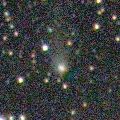
|
It reached up to 11-12 mag from spring to summer in 2008. Now it is fading. It locates already high in the Southern Hemisphere, and it will be getting higher in the Northern Hemisphere, but it will be fainter than 18 mag soon.
Date(TT) R.A. (2000) Decl. Delta r Elong. m1 Best Time(A, h)
Aug. 28 5 52.03 -9 35.6 6.881 6.617 70 17.9 5:01 (242, 48)
Sept. 4 5 53.03 -9 46.0 6.839 6.668 76 17.9 4:51 (238, 51)
|
|
![]()
 81P/Wild 2
81P/Wild 2 C/2006 S3 ( LONEOS )
C/2006 S3 ( LONEOS ) C/2008 FK75 ( Lemmon-Siding Spring )
C/2008 FK75 ( Lemmon-Siding Spring ) C/2009 F4 ( McNaught )
C/2009 F4 ( McNaught ) C/2007 Q3 ( Siding Spring )
C/2007 Q3 ( Siding Spring ) C/2010 B1 ( Cardinal )
C/2010 B1 ( Cardinal ) C/2010 A4 ( Siding Spring )
C/2010 A4 ( Siding Spring ) 240P/2010 P1 ( NEAT )
240P/2010 P1 ( NEAT ) 126P/IRAS
126P/IRAS C/2008 S3 ( Boattini )
C/2008 S3 ( Boattini ) 219P/2009 H1 ( LINEAR )
219P/2009 H1 ( LINEAR ) 215P/2009 B5 ( NEAT )
215P/2009 B5 ( NEAT ) C/2010 J2 ( McNaught )
C/2010 J2 ( McNaught ) 223P/2009 L18 ( Skiff )
223P/2009 L18 ( Skiff ) C/2009 UG89 ( Lemmon )
C/2009 UG89 ( Lemmon ) P/2010 J3 ( McMillan )
P/2010 J3 ( McMillan ) P/2010 A5 ( LINEAR )
P/2010 A5 ( LINEAR ) 116P/Wild 4
116P/Wild 4 164P/Christensen
164P/Christensen 236P/2010 K1 ( LINEAR )
236P/2010 K1 ( LINEAR ) C/2009 U1 ( Garradd )
C/2009 U1 ( Garradd ) C/2007 G1 ( LINEAR )
C/2007 G1 ( LINEAR )![]()


























